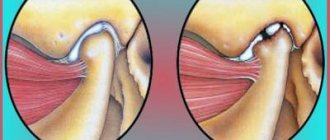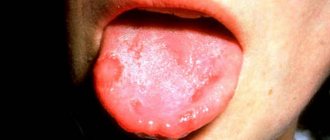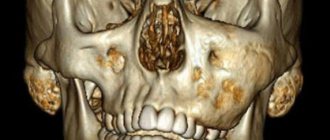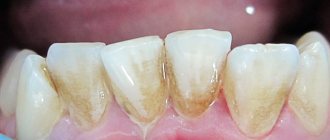Classification of fluorosis
The disease is divided into degrees of severity:
- The first is doubtful fluorosis. These are barely noticeable white spots on the enamel that become better visible when the surface dries.
- The second is very weak. Opaque white spots occupy up to 25% of the enamel surface.
- The third is weak. The lesion covers from 25 to 50%.
- The fourth is moderate. The surface of the tooth is completely damaged, abrasion and brown spots are noticeable on the enamel, and the relief is modified.
- Fifth – heavy defeat. There are significant brown areas and serious enamel destruction.
Fluorosis in children
Children's bodies are more sensitive to fluoride. The increased rate of metabolic processes leads to the rapid accumulation of this element in bones and organs, causing changes in their structure and functionality. The main impact falls on children living in conditions of excess fluoride until the age of 3 (the period of formation of the rudiments of permanent teeth). Large doses of the microelement destroy ameloblasts, the cells responsible for the development of enamel structures. At the same time, baby teeth can have a completely healthy appearance. They are rarely affected by fluorosis, since their formation occurs during the intrauterine period, when the child is reliably protected from excess fluoride by the mother’s placental barrier.
Attention! Children's toothpastes should contain reduced levels of fluoride or no fluoride at all. This is especially true for regions where fluoridation of drinking water is practiced.
Forms
The streak form is characterized by barely noticeable stripes in the subsurface enamel layer. They are hardly noticeable and form on the vestibular surface of the incisors.
In the spotted form, chalky spots alternate with areas of healthy enamel. The incisors are most often affected. Sometimes the formation takes on a yellowish-brown tint. But the enamel always remains smooth and dense, with an intact structure.
The chalky mottled form has various symptoms. Distinct pigmented spots are visible on the enamel. The enamel may be yellow, with spots and dots, and other minor defects. It quickly wears away, exposing pigmented dark brown dentin.
The erosive form is accompanied by unaesthetic erosions on which there is no enamel. Destructive is characterized by a violation of the shape of the crowns of the teeth due to abrasion of hard tissues. They become brittle and break off easily, but due to the formation of replacement dentin, the tooth cavity is not opened.
Diagnostic methods
Diagnosing dental fluorosis is not difficult. The doctor relies on the clinical picture characteristic of each degree of damage. Differential diagnosis includes:
- Mild opacity of the enamel is detected by drying the surface to assess the condition of the protective layer in the area with altered pigmentation.
- Vital staining method - in case of fluorosis, the affected areas of the enamel are not subject to staining with methylene blue, unlike a carious defect.
- Luminescence study - mild types of the disease glow weakly in ultraviolet light; in moderate and severe forms, partial quenching of fluorescence occurs.
- Microradiography is aimed at determining the depth of damage to dentin tissue.
Drinking water must be sent to the laboratory for analysis to determine the percentage of fluoride compounds.
Subtleties of differential diagnosis of fluorosis
It is very important to distinguish fluorosis from enamel hypoplasia, especially from its patchy form. Chalky spots in both diseases are located symmetrically, in areas of the crown that are not typical for caries. As a rule, these are the labial and lingual surfaces, cusps and cutting edge. With fluorosis, they have a pearly white tint, are shiny, do not cause pain during probing, and gradually turn into healthy enamel.
With hypoplasia, the spots are white and dense, also shiny, but with clear boundaries. Under the influence of UV rays, with fluorosis, chalky spots give a light blue glow (pigmented ones - red-brown), with hypoplasia - light yellow. Fluorosis is not prone to changes in spots, while formations with hypoplasia often require treatment for caries in children, since they change and progress.
Symptoms
Dental fluorosis is characterized by the appearance of pale spots or numerous stripes on the enamel. As the disease progresses, the defects acquire a yellow, brownish tint. Defects most often affect the maxillary incisors; against the background of excessive concentrations of fluoride compounds, the disease covers all teeth. Increased abrasion of the enamel develops, chips and erosive areas appear on it. Symptomatic manifestations depend on the type of pathology:
- Styriform fluorosis
small stripes
(strokes) appear on the enamel - Spotted
- this form is characterized by the appearance of numerous whitish (chalky) spots joining together. The spots have a smooth, glossy surface (similar to caries in the spot stage). Unlike a carious defect, they do not have clear boundaries, but smoothly merge with healthy areas of enamel. - Chalky-mottled
- pigment spots are formed with clear boundaries, multiple dots are visible. The enamel layer turns yellow, quickly thins, dentin is exposed, and the tooth becomes very sensitive to mechanical, chemical, and thermal irritants. - Erosive fluorosis
- volumetric defects appear - erosion. Tooth enamel in these areas is completely absent, dentin tissue is exposed. - Destructive
- a severe degree in which not only enamel, but also dentin is destroyed. The tooth is fragile, susceptible to chips and fractures, the crown part is deformed, the defects are very noticeable.
The destructive type is found in areas where the level of fluoride compounds in water is 10 mg/l or higher. Pathology can cover several dental units or the entire row.
Treatment of fluorosis
The treatment regimen depends on the severity of the disease, general health and the influence of endemic factors. Therapy solves the following problems:
- reduce excessive intake of fluoride into children’s bodies from drinking water and food products;
- weaken the toxic effect of increased concentrations of fluoride on the body (the child is prescribed calcium preparations that bind fluoride and remove it).
Topical treatment for fluorosis depends on the severity. For any clinical picture, it is recommended to brush your teeth twice with toothpastes that contain calcium glycerophosphate, for example “Pearls” or “Calcium Complex”. At the first stage, no further action is required.
In the presence of pigmented spots, whitening is sometimes carried out followed by remineralization - only after 16 years under the supervision of a dentist. There are other methods of combating age spots, for example, removing pigmented enamel using microabrasion.
In erosive and destructive forms, when there is loss of hard tissue, the anatomical shape of the tooth can be restored with composite materials. Orthopedic treatment is sometimes indicated.
Classification
Based on anthropogenesis, fluorosis is divided into endemic and occupational. Although the clinical manifestations of both types of disease are similar, the treatment approach is different. In the professional form of the disease, not only tooth enamel is affected, but also bone tissue, and osteosclerosis and osteoporosis develop. As the disease progresses, disorders of the vascular system and liver occur, and the risk of developing osteosarcoma increases many times over. In this case, fluorescent spots on the enamel layer are often absent.
Forms of fluorosis:
- spotted;
- dashed;
- erosive;
- chalky mottled;
- destructive.
Spotted and streaked fluorosis is a mild type of pathology, erosive and destructive are classified as severe. A patient can be diagnosed simultaneously with different forms of the disease - different clinical pictures are observed on individual dental units and groups of teeth.
Prevention of fluorosis
Prevention of fluorosis should be carried out in geographic areas where the fluoride content in drinking water exceeds 2 mg/l. Ideally, it is desirable to solve this problem collectively - to eliminate the etiological factor. If this is not possible, drinking water is defluoridated using a reagent or filtration method. Such water is also mixed with water from artesian wells or mountain rivers to reduce the concentration of fluoride. You can also remove fluoride from water at home by freezing, boiling and settling, and filtering through a layer of magnesium oxide.
Individual prevention involves the use of imported clean water for cooking. It is very important to limit the consumption of foods high in fluoride - strong tea, sea fish, seafood. In the winter-spring period, children from 2-3 years of age at risk are prescribed calcium supplements for a month, as well as ascorbic acid.
Etiology and forms
Fluorine is an essential element of mineral metabolism, participates in hematopoiesis, the formation of bone tissue and teeth, prevents the development of caries, and also ensures the removal of heavy metal salts from the body. The chemical compound enters through the respiratory tract, skin and digestive tract. Fluoride accumulates in the body and accumulates in teeth, connective and bone structures.
The disease is occupational or endemic in nature, that is, it is characteristic of a certain geographical area. There are also five main forms of mild, moderate and severe:
- spotted;
- dashed;
- chalky-speckled;
- erosive;
- destructive.
Fluorosis affecting the first set of teeth in children is rare and in most cases goes away on its own when temporary units are replaced with molars. Pathological changes, as a rule, occur during the eruption of permanent teeth in children living in areas with increased concentrations of the chemical element in water. With a pronounced degree of fluorosis, the risks of carious processes are high.
Dental fluorosis
Fluorosis, or chalky speckled enamel, is a disease that occurs due to prolonged intake of a large dose of fluoride into the body. The content of this microelement in bones is affected by the composition of drinking water. Fluoride is also found in food and even in toothpastes, but from there it is absorbed much worse than fluorides found in water. Therefore, fluorosis is endemic, that is, it is a disease characteristic of a certain area where the water is oversaturated with fluoride. There is also occupational fluorosis - it occurs in workers of enterprises where the content of fluoride compounds in the air is exceeded. However, this type of disease is not very common among the population.
The most susceptible to endemic fluorosis are children and adolescents whose permanent teeth have not yet erupted or whose enamel has not yet strengthened. The daily need for fluoride at this age is 2–3 mg, which the child receives from food and water. For the development of the disease, the maximum permissible concentration of fluoride in water – 1.5 mg/l – will be sufficient. Adults with already formed tooth enamel, even with prolonged use of such water, will not get fluorosis, since the daily norm is already 4 mg. However, if the fluoride content exceeds 6 mg/l, then the teeth of the adult population are also affected. You can find out about the fluoride content in the water in your region by calling the nearest branch of the Sanitary and Epidemiological Station.
Attention!
A fluoride concentration in water of less than 1.5 mg/l also leaves 10–30% of the population at risk of developing fluorosis.
Symptoms of fluorosis
This disease has many symptoms, the main ones are:
- Characteristic streaks, spots or discoloration on tooth enamel that are chalky or brown in color
- Damage to enamel
- Visible defects in the enamel,
- Matte and rough enamel,
- Weakness of teeth
- Teeth are crumbling
- Changes in tooth shape
- Increased susceptibility to caries.
Ingestion of large amounts of fluoridated dental gel can cause toxicity, accompanied by diarrhea, vomiting and severe abdominal pain.
Symptoms of fluorosis that lasts a long time:
- Pain in bones, muscles and joints,
- Bone deformation
- Headache,
- General weakness and apathy,
- Paresthesia and muscle twitching,
- Damage to the nasal mucosa, rhinitis,
- Gingivitis,
- Liver and kidney diseases.
Treatment
Very mild and mild forms of fluorosis do not require mandatory treatment. If you do teeth whitening with subsequent remineralization of the enamel, the prognosis for improving appearance with this, the most gentle type of intervention, is very favorable. Immediately, on the day of bleaching, the spots may become more noticeable, but then their brightness decreases and approaches the color of healthy enamel. If the achieved result is imperfect, the whitening procedure can be repeated 2-3 times. Remineralization of enamel should be carried out after etching with acid - this will dissolve fluorapatite crystals and subsequently replace them with hydroxyapatite. For moderate cases, it is also best to start with the least invasive option - teeth whitening. The probability of removing stains in this case is also quite high. If the whitening effect is insufficient, you can try microabrasion of the enamel - gentle superficial grinding of the affected areas, also after preliminary etching. If bleaching and microabrasion fail, restoration with fillings or veneers can be considered. It is worth noting that some patients consider the conversion of yellow-brown spots to matte white to be a worthy result and refuse further restoration treatment. In severe cases, bleaching is ineffective. In case of minor enamel damage and no patient complaints, observation is recommended. There is no need to chase every small defect with a bur, drilling out as much more healthy enamel along the way (especially outside the visible smile zone). If the damage has already formed cavities where food debris accumulates, then the need for restoration treatment arises. Filling, inlay, onlay, veneer or crown - the type of restoration is determined by the area and volume of the lesion.
Prevention measures
- Maximum duration of breastfeeding for infants in areas with unfavorable endemic conditions
- Drinking water with normal fluoride content (bottled or purified with a special filter)
- Balanced diet. At the same time, we do not forget that this element is still necessary for the formation of bones and the prevention of the development of caries
- Additional intake of calcium and phosphorus supplements (they promote the removal of fluoride)
- Using fluoride-free toothpastes and rinses
The dental network offers diagnostic services and effective treatment of dental fluorosis of any form. Contacting our specialists has the following advantages:
- treatment by highly qualified doctors;
- compliance with international standard treatment protocols;
- family and savings discounts;
- transparent pricing;
- daily work schedule until 21:00 (on Sunday until 16:00).
You can make an appointment at any of the branches of our clinic in Moscow, located within walking distance from metro stations:
- Art. Alekseevskaya (VDNKh district, etc. Mira), address: st. 3rd Mytishchiskaya house 3, building 2;
- Art. Shelepikha, address: Shelepikhinskaya embankment, address: building 34, building 1.
Modern equipment and a high level of specialist training allow us to provide comprehensive medical services. We are ready to help patients with any clinical case and offer solutions to the problem. Your health is in good hands!
Excess fluoride and the appearance of fluorosis
Fluorine is one of the microelements needed by the body. Most of it is found in hard tissues (bone tissue, dentin). The body receives it from food and water. Absorption is slow, in small quantities. We get most fluoride from water (in the form of a fluoride solution). Their concentration should be 1 mg/l (for drinking water). At higher concentrations, hard tissues lose strength, which increases the risk of carious lesions. When there is oversaturation of fluoride, destruction of hard tissues begins and fluorosis appears.
Degrees of development
This disease develops slowly because it is quite complex and serious. According to doctors, it is worth highlighting the following stages of fluorosis development:
- 1st degree. Here small spots appear on the tooth enamel and its surface. But some teeth suffer, not all;
- 2nd degree. It is worth noting the chalky spots here, but pigmented spots also appear that are pronounced. They have a yellow, brown tint;
- 3rd degree. Most of the enamel is affected, and the crown may become deformed. In addition, enamel is soft and can be worn out. In this case, the tooth remains without its protection.
What is the danger of the disease?
If fluorosis treatment is not started in a timely manner and the root cause of the pathological process is not eliminated, this is fraught with serious consequences. In addition to aesthetics, teeth will become weak, crumbly, and ultimately this can lead to tooth loss. In addition, in advanced stages, any treatment is ineffective; the only way out of the situation will be prosthetics or dental implantation. In addition, high levels of fluoride are not only harmful to tooth enamel, but can also trigger more serious diseases such as osteoporosis.
How does dental fluorosis manifest?
Dental fluorosis is primarily manifested by external changes in the tooth enamel - spots of various sizes and colors (chalky, dirty yellow, dirty brown) appear on the tooth surface. The stains are located on the entire outer surface of the tooth, but in different quantities. As a rule, fluorosis affects adjacent or symmetrical teeth - central incisors, front teeth.
At the beginning of the development of enamel fluorosis, the patient most often discovers small and white dots on the teeth. Instead of dots, stripes may also form. The first teeth affected by fluorosis and the ones that react most sensitively to fluoride are the incisors. As the disease develops, other teeth in the mouth are also affected.
Over time, the initially formed spots begin to darken and acquire a dirty hue. This is evidence that the disease is entering a chronic stage.
Bleaching for fluorosis
Many people wonder if teeth whitening will help with fluorosis? This method can be applied to the streaked or spotted form, when the spots still have a white tint. Whitening will even out the color of teeth and stains. Minor defects can also be sanded down and the enamel remineralized. If the spots darken, it will be possible to get rid of fluorosis only with the help of prosthetics with orthopedic structures such as veneers, lumineers or crowns.
How is the diagnosis carried out?
The primary diagnosis is based on examination of the oral cavity and collection of anamnesis with a patient interview. It is very important to determine the place of residence of a person under the age of 3-4 years, as well as the presence of similar deviations in close relatives.
Instrumental diagnostics:
- measure the electrical resistance of hard tooth tissues - healthy enamel does not conduct current;
- luminescent diagnostics with staining - the study reveals subtle areas of enamel clouding and the presence of early erosions.
In differential diagnosis, it is necessary to compare general signs with the symptoms of early caries, hypoplasia, wedge-shaped defect and other non-carious enamel damage.
Typical symptom complex of fluorosis:
- white spots usually appear immediately after teething;
- there are several spots/stripes on one tooth at once;
- all or the vast majority of units of the dentition are affected, and not its individual structures.
Treatment of illness at home
- First of all, to treat the disease at home, it is necessary to reduce the intake of fluoride into the body and ensure proper dental care. To do this, you need to use the following recommendations:
- If there is a high fluoride content in drinking water and it is not possible to completely abandon it, you can use special filters designed to defluoridate it.
- Water can be boiled or frozen. Freezing is carried out in a suitable container. Once the liquid is completely frozen, it is left to defrost at room temperature. In this case, it is necessary to observe the process until one or more small ice cubes remain in the liquid. They need to be removed and thrown away, since this is where harmful substances and trace elements of fluoride are collected.
- It is recommended to use special toothpastes for the treatment and prevention of the disease. They contain chelating and remineralizing agents that help restore damaged areas and prevent further destruction of foci of fluorosis. For example, ASEPTA PLUS REMINERALIZATION paste will help reduce the rate of enamel destruction. It does not contain fluorides or aggressive abrasives and is suitable even for sensitive teeth.
- Do not use teeth cleaning products or mouthwashes that contain fluoride.
- It is necessary to limit the consumption of fluoride-containing products. The diet should include foods rich in phosphorus and potassium, as they help quickly remove excess fluoride from the patient’s body.
- Recommended supplements:
- Lactic acid salts.
- Salts of pyruvic acid.
- Calcium.
- Magnesium.
- Vitamins A, B, C, R.
Features of the disease
Fluorosis is a non-infectious and non-inflammatory chronic disease that develops when the level of fluoride in the body increases. With fluorosis, all teeth can be damaged, but intensive destruction of the enamel of the upper incisors is predominantly observed.
A distinctive feature of fluorosis from caries is the formation of not only white spots on the enamel, but also stripes, specks, etc. Gradually, destruction occurs, and cracks and chips form on the affected teeth. In advanced cases, the tooth can completely collapse, exposing dentin.
The risk group includes children during the period of change from primary to permanent dentition. Fluorosis is less common in adults, but is no exception. The disease develops slowly. It is characterized by the onset of periods of exacerbation and remission.
Pathogenesis
During normal enamel formation, matrix proteins (ameloblastin and amelogenin) are gradually replaced by growing hydroxyapatite crystals. The space between adjacent enamel prisms is minimized.
When there is an excess of F- ions, they are more quickly incorporated into the crystal lattice than the larger and asymmetric OH- ions. Fluoridated enamel preserves matrix proteins. As a result of incomplete crystal growth, significant spaces remain along the periphery. The penetration of food pigments turns these cavities brown. Porosity of enamel in severe forms of fluorosis contributes to the spread of caries and increases the risk of chipping from mechanical stress.










